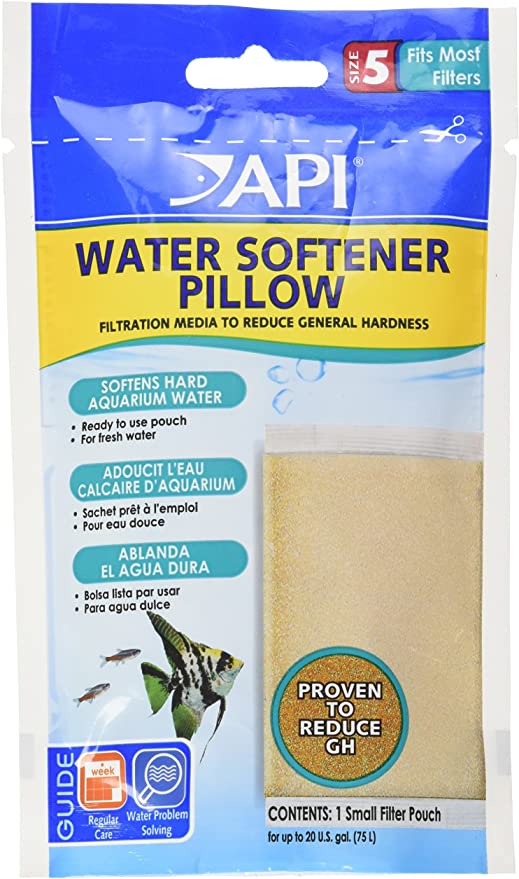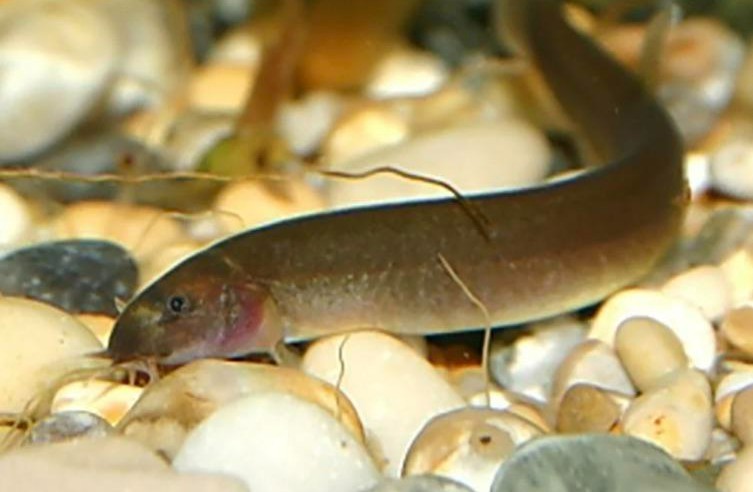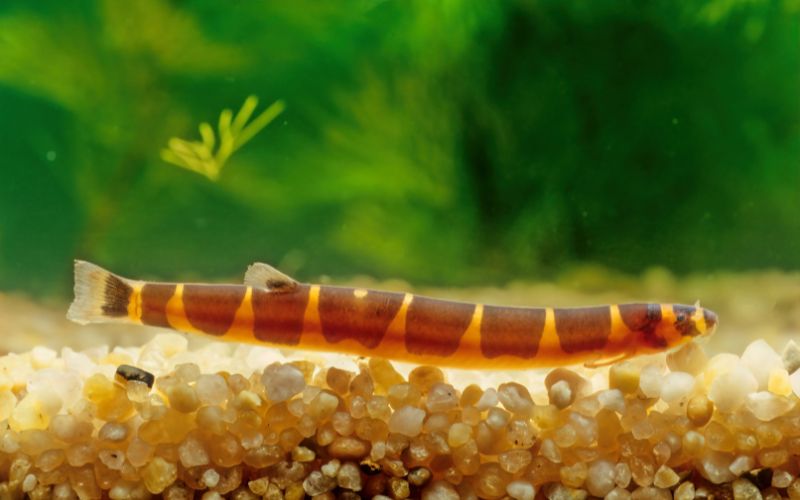Kuhli Loaches can live in a relatively wide range of tank conditions but are sensitive to changes in their water. Read on for a run-down of the ideal Kuhli Loach water parameters.
What pH do Kuhli Loaches like?
Kuhli Loaches thrive in slightly acidic water, with a pH of 5.5 to 6.5, although owners have had success in both slightly acidic and slightly alkaline water. As long as the pH in your tank is stable, your Kuhlis should be fine.
If you’re looking to breed Kuhli Loaches, you’ll need slightly acidic water of between 6-6.5 pH. Otherwise, don’t chase pH too much, but go for stable levels instead.
The reason for this is that most pH recommendations match the conditions of the fish’s natural habitat. Most store-bought fish will be tank-bred, which means they haven’t experienced those conditions.
Therefore, the number one consideration is that the pH of your tank is close to that of the store. Always ask what the pH is when you buy your fish, and if there is a 0.5 difference or greater you may need to drip acclimate.
If you find yourself in this situation, drip acclimation ensures that your Kuhlis get used to the pH levels in your tank over a longer period of time.
This prevents your fish from suffering from pH shock, which happens when they experience sudden changes in pH and can kill fish.
What to do if your pH suddenly drops or increases
There are many reasons your tank’s pH may change suddenly, and this can be dangerous for your fish.
Most fishkeepers know that if you accidentally over-feed your fish or one of them dies, this can cause an ammonia spike. However, it can also drop the pH dramatically.
If this happens, your fish can suffer from pH shock. The quickest way to avoid this is to do a large water change, and treat the new water with a pH-raising solution:

These products neutralize acidity in the water, raising the overall pH in the aquarium.
They’re fast-acting too, as I found when I needed to increase the pH in my Betta tank. Be aware of this and treat a little at a time so as not to overdose your tank.
if your tank pH increases (become more alkaline), there are also pH lowering solutions you can buy:

Kuhli Loach water hardness
The ideal level of water hardness for Kuhli Loaches is between 0-5 dGH. Kuhlis prefer soft water to help them grow and ensure a long and happy life, so test your tap water and keep your tank water below 10 dGH as a maximum.
For a Kuhli Loach, hard water is only a major issue if they’re wild-caught. As with pH, captive-bred fish have existed their entire lives in water conditions that will be different from those in their natural habitat.
Many Kuhli Loaches are wild caught, so always speak to your fish store about water parameters. Find out if they were captive-bred or wild-caught and whether water hardness has been considered.
If you live in a hard water area, you can use this water softener pillow:

This product sits inside your canister filter to remove dissolved minerals, lowering water hardness.
Do Kuhli Loaches need a heater?
Kuhli Loaches are tropical fish, so in most cases, they need a heater in their tank to keep the water warm. The best temperature for Kuhli Loaches is between 75-86°F (24-30°C). This matches the temperature in their natural habitat in the rivers and streams of Malaysia and Indonesia.
If you live in a hot climate you might not need a heater to achieve this, but be aware that Kuhlis can’t survive for long if the temperature drops below this range.
How To Regulate Your Kuhli Loach Tank Temperature
There are some great aquarium heaters available from pet stores and online, but there is a product that many fish owners are turning to that is something of a game-changer.
Inkbird ITC-306A WiFi Temperature Controller

- Protects fish from overheated water
- Dual display window; displays measured and set temperature at same time
- High and low temperature alarms
- Heating time can be set from 1-72 hours if needed
It’s difficult to avoid temperature swings that can be harmful to fish, especially when your room experiences high temperatures in summer or the temperature drops in winter.
Unlike regular tank heaters, the Inkbird allows you to keep on top of your water temperature with a number of unique features.
You can pair the aquarium temperature controller with your phone via 2.4GHz Wi-Fi the INKBIRD app will alert you with push notifications if it senses a problem.
The aquarium temperature controller is equipped with 2 relays to ensure that the power can be turned off under any circumstances, this will protect your fish from being hurt by overheated water (US Socket Only).
The controller uses two probes, in case one stops working. The dual probe aquarium temperature controller will alarm if the temperature difference between 2 probes is bigger than 3°C/5°F, and the INKBIRD app will send a push notification to your phone to alert you.
The heating time can be set according to your needs from 1 hour to 72 hours, and the controller will alarm if water can not be heated to the setting temperature within the specified time.
The 1100w high-power aquarium temperature controller is compatible with most kinds of heaters, so you don’t need to assemble the product yourself, just plug and play.
If you want complete peace of mind, this product takes total care of your water temperature.
Kuhli Loaches and ammonia
Kuhli Loaches are sensitive to ammonia spikes and their tank needs to be free of ammonia at all times.
Uneaten food, dead plant leaves, and dead fish can all cause ammonia spikes. To avoid this, make sure you don’t over-feed, clear any dead plant matter out of the tank, and remove any dead fish.

Kuhlis are bottom feeders who help the general health of a tank by cleaning up any uneaten food.
Kuhli Loaches are not fussy eaters, and will happily munch down their tank mates’ leftovers. They are also a low-bioload fish as they produce relatively little waste.
Even so, you can’t rely solely on your cleanup crew to avoid ammonia. Only feed what your Kuhlis and their tank mates can eat in two minutes, and keep the tank clean of dead plants and fish.
Always test your water regularly for ammonia using a water testing kit like this one:

If you find that you have ammonia in your tank, start performing daily water changes, removing around 20% of the water until you get a clear ammonia test.
Note: always make sure you use a water conditioner when performing water changes, as tap water can contain harmful chemicals. Water conditioners take around 24 hours to detoxify all the water in your tank, which is why there’s no point doing water changes more than once a day.
If you’re seeing high levels of ammonia (greater than 2ppm), you’ll need to change more of your water. Remember that if your ammonia has spiked to 4ppm and you change 50% of the water, you can expect levels of 2ppm after a single water change.
This means you’ll need to do more than one water change. You’ll sometimes need to change large amounts of your tank water daily to gradually lower the ammonia. Eventually, the beneficial bacteria will take over and eliminate any remaining ammonia in your aquarium.
If this doesn’t work, check out this guide on what to do if water changes aren’t lowering ammonia.

Nitrite
Nitrates are produced when beneficial bacteria consume whatever low levels of ammonia exist in your tank.
Nitrite is the waste product of this process, which is a natural part of a healthy aquarium. Higher levels of nitrite are still toxic to fish, but they’re safer than ammonia.
Always test your water parameters regularly to make sure your tank water is clear of nitrite. If you test and find you have nitrite levels of 0.25ppm or more, start performing daily water changes until your nitrite reading is zero.
Nitrate
In a healthy aquarium with an established nitrogen cycle, low levels of nitrate are to be expected.
This is because when ammonia is turned into nitrite, the nitrite is then consumed by beneficial bacteria and converted to nitrate.
Nitrate is the least toxic chemical in this process. Nitrate levels of 10 ppm or below are perfectly safe, but 20 ppm or above need to be monitored and ideally reduced.
Over 40ppm, fish become stressed and vulnerable to disease. Nitrates at this level also stunt the growth of juveniles, and high levels can kill fish.
The solution to high nitrate levels in your tank is the same as treating ammonia and nitrate. Perform daily water changes until your levels return to normal, replacing the poor-quality water with treated, clean tap water.

Summary
Kuhli Loaches are a relatively easy fish to care for but they are sensitive to changes in water conditions.
Use the below as a rough guide, but make your main concern should be keeping the pH and temperature stable and avoiding spikes of ammonia, nitrite, and nitrate.

Always test your Kuhli Loach tank parameters regularly. I test a couple of times a week but always test more frequently than this in a new aquarium (ideally daily). Always make sure your tank is fully cycled before adding your fish!
Finally, if you see fluctuations in pH, address them quickly to bring the water back to around 5.5-6.5 pH so your Kuhli Loaches don’t become sick or even die.
If you see spikes in ammonia, nitrite, or nitrate, perform daily water changes, changing more water for higher levels of these toxins.
In the meantime, if you have any other questions about these wonderful fish, you’ll find everything you could possibly need to know in this Kuhli Loach care guide.
